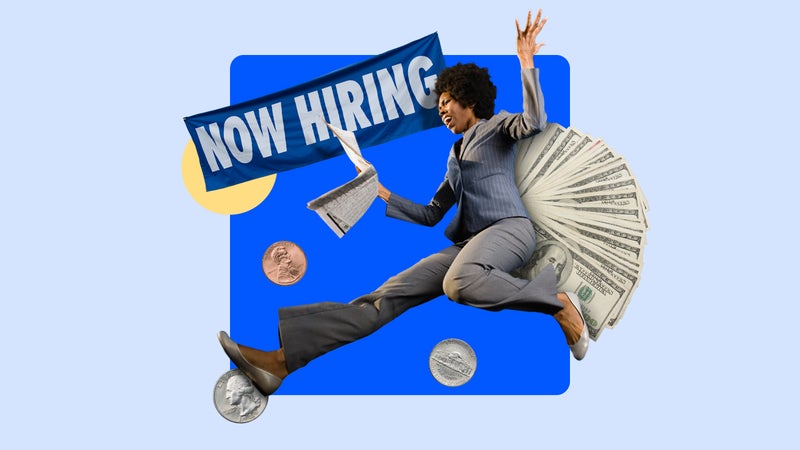Survey: Odds of a recession by September 2024 fall to 46%

The Bankrate promise
At Bankrate we strive to help you make smarter financial decisions. While we adhere to strict , this post may contain references to products from our partners. Here's an explanation for .
The nation’s top economists say the U.S. economy’s chances of avoiding a recession are improving — but risks of one remain.
Recession odds between now and September 2024 have dropped to 46 percent, according to experts’ average forecast in Bankrate’s latest quarterly survey of economists. Those probabilities are still close to a coin flip, but they’re down from an average forecast of 59 percent just last quarter. They’re also the lowest odds since the first quarter of 2022.
Most economists (59 percent) also now say the odds of a recession over the next year are lower than 50 percent. It’s a stark contrast to the previous quarter survey: In July, the majority of respondents (or 78 percent) indicated that the percentage chance of a recession over the next 12 months was greater than 1-in-2.
It is quite remarkable that we’ve gone close to two years now where we’ve been on high alert for a recession, and yet one has yet to materialize for the broader U.S. economy. Unfortunately, the odds of an economic contraction remain elevated.— MARK HAMRICK | BANKRATE SENIOR ECONOMIC ANALYST
Key insights on the economy from Bankrate’s third-quarter Economic Indicator poll
Is a recession not coming to wreck the economy’s party — or is it just late?
Economists’ recession forecasts in the third-quarter poll ranged from a low of 15 percent to as high as 90 percent. Almost 1 in 4 (or 24 percent) say the chances of a recession are at 25 percent or less. Unlike the previous quarter poll, no economist is suggesting a recession is a certainty, putting the odds at 100 percent.
Those forecasts show an improved outlook for the U.S. economy. As the job market roars on, consumers are able to keep spending — acting as an engine for more economic growth and helping the financial system avoid the downturn that has long been expected.
We believe there is a large chance that the economy can achieve a soft landing given how strong economic data has shown. While there remain risks to the outlook from the UAW strike, a government shutdown and the lagged impact of rate hikes, we expect the economy will muddle through the rest of 2023 and 2024 without sinking into a downturn.
— Tuan NguyenEconomist at RSM
At the same time, more than 2 in 5 (or 41 percent) said the economy’s chances of entering a recession are greater than 50 percent, implying that many economists still believe a downturn is still more probable than not.
Economists say the U.S. economy might not have fully caught up to the Federal Reserve’s rapid and massive rate hikes. Estimates suggest it often takes a full year, if not more, for each rate hike to make its way through the system. Fed officials began raising interest rates in March 2022. Only in July did they lift them up to a 22-year high of 5.25-5.5 percent.
Chairman Powell has expressed hope that the Federal Reserve can achieve a ‘soft landing’ for the economy by taming inflation without tipping it into recession. That possibility is still on the table, but monetary policy’s long and variable lags complicate the picture.
— Odeta KushiDeputy chief economist at First American Financial Corporation
Even the economists who are penciling in odds of less than 1-in-2 suggest that downside risks remain. Further oil price shocks that exacerbate inflation by lifting gasoline prices may complicate the picture, as could the return of student loan payments, a risk of a government shutdown in November and ongoing strikes among auto workers.
With real gross domestic product (GDP) on track to grow robustly in third quarter, a recession isn’t on the near-term horizon, but the economy faces imminent risks. The triple threat from the resumption of student loan payments, a government shutdown and a strike by auto union workers could significantly weigh on GDP growth in Q4 and add to downside risks already impacting the economy.
— Gregory DacoChief economist at EY
Economists who do expect a recession say a downturn could begin at some point in the first half of 2024. But most note that the impact would likely be modest, resulting in fewer job opportunities but lower unemployment that might help Americans find new positions relatively quickly even if they are laid off.
Our forecast is for a short, mild recession beginning in early 2024. The prospects for a true soft landing have certainly improved over the past quarter. However, we still view a recession in the first half of 2024 as the most likely path for the economy.
— Mike FratantoniChief economist, Mortgage Bankers Association
-
The Third-Quarter 2023 Bankrate Economic Indicator Survey of economists was conducted Sept. 9-26. Survey requests were emailed to economists nationwide, and responses were submitted voluntarily online. Responding were: Mike Fratantoni, chief economist, Mortgage Bankers Association; Odeta Kushi, deputy chief economist, First American Financial Corporation; Tuan Nguyen, economist, RSM US LLP; Bernard Baumohl, chief global economist, The Economic Outlook Group; Yelena Maleyev, senior economist, KPMG US; John E. Silvia, founder, Dynamic Economic Strategy; Gregory Daco, chief economist, EY; Brian Coulton, chief economist, Fitch Ratings; Michael Pearce, lead U.S. economist, Oxford Economics; Scott Anderson, chief U.S. economist, BMO; Dante DeAntonio, senior director, Moody’s Analytics; Lawrence Yun, chief economist, National Association of Realtors; Bernard Markstein, president and chief economist, Markstein Advisors; Robert Frick, corporate economist, Navy Federal Credit Union; Bill Dunkelberg, chief economist, NFIB; Mike Englund, chief economist, Action Economics; and an economist at a private-sector analytics firm who asked to remain anonymous.
